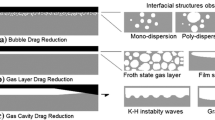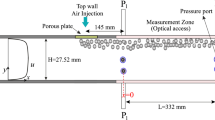Abstract
Skin-friction drag reduction in (water) turbulent boundary layers using bubble injection has been studied for some time. Ceccio (Annu Rev Fluid Mech 42:183–203, 2010) and Murai (Exp Fluids 55(7):1–28, 2014) have compiled drag reduction data from a number of different studies and facilities, and highlighted the large differences and scatter in the data even at the same bubble void fraction. Motivated by this, in the present work, we experimentally investigate within a single horizontal turbulent channel facility, drag modification using bubbles over a wide range of bubble void fraction (\(0< \alpha < 0.15\)), channel Reynolds number (22,500 \(< Re<\) 67,500), and the orientation of bubble injection (top/ bottom wall). In each of the cases, we have simultaneously measured drag modification and visualized the bubble dynamics. The drag modification is obtained from measurement of the mean pressure drop at four different vertical locations within the channel. The results show that even in the same facility, the drag reduction obtained at a fixed void fraction (\(\alpha\)) can be very different due to changes in bubble dynamics caused by changes in the other flow parameters. The visualizations show a number of bubble dynamics regimes depending on the parameters, with possibilities of both increased and decreased drag compared to the base (no bubble) case. The measurements for the bubble cases show significant vertical variations in the measured pressure drop within the channel, with these vertical variations being also dependent on the bubble distribution/dynamics. Interestingly, in some cases, the pressure drop at a given height even becomes negative, although the integrated pressure drop over the channel height, which is related to the overall drag, remains positive but lower than the base case. In terms of the overall drag, the top-wall injection is observed to give good drag reduction over a wide range of flow Re and \(\alpha\), but is seen to saturate beyond a threshold \(\alpha\). In contrast, the bottom-wall injection case shows that drag continuously decreases with \(\alpha\) at high channel Re, while at low channel Re, the drag is found to continually increase with \(\alpha\). The present study shows a maximum of about 60% increase and a similar 60% reduction in wall drag over the entire range of conditions investigated. For each of the bubble wall injection orientations (bottom/top/both wall), contour plots of drag modification and gain factor (fractional drag reduction per unit void fraction) are presented in the plane of \(\alpha\) and Re along with the corresponding bubble dynamics, which helps to delineate the different regimes seen in such bubbly channel flows.
Graphic abstract











Similar content being viewed by others
References
Ceccio SL (2010) Friction drag reduction of external flows with bubble and gas injection. Annu Rev Fluid Mech 42:183–203
Coles D (1956) The law of the wake in the turbulent boundary layer. J Fluid Mech 1(2):191–226
Dean R (1978) Reynolds number dependence of skin friction and other bulk flow variables in two-dimensional rectangular duct flow. J Fluids Eng 100(2):215–223
Elbing BR, Winkel ES, Lay KA, Ceccio SL, Dowling DR, Perlin M (2008) Bubble-induced skin-friction drag reduction and the abrupt transition to air-layer drag reduction. J Fluid Mech 612:201–236
Elbing BR, Mäkiharju S, Wiggins A, Perlin M, Dowling DR, Ceccio SL (2013) On the scaling of air layer drag reduction. J Fluid Mech 717:484–513
Ferrante A, Elghobashi S (2004) On the physical mechanisms of drag reduction in a spatially developing turbulent boundary layer laden with microbubbles. J Fluid Mech 503:345–355
Gabillet C, Colin C, Fabre J (2002) Experimental study of bubble injection in a turbulent boundary layer. Int J Multiph Flow 28(4):553–578
Guin MM, Kato H, Yamaguchi H, Maeda M, Miyanaga M (1996) Reduction of skin friction by microbubbles and its relation with near-wall bubble concentration in a channel. J Mar Sci Technol 1(5):241–254
Hara K, Suzuki T, Yamamoto F (2011) Image analysis applied to study on frictional-drag reduction by electrolytic microbubbles in a turbulent channel flow. Exp Fluids 50(3):715–727
Jacob B, Olivieri A, Miozzi M, Campana EF, Piva R (2010) Drag reduction by microbubbles in a turbulent boundary layer. Phys Fluids (1994–present) 22(11):115,104
Jha NK, Govardhan R (2015) Interaction of a vortex ring with a single bubble: bubble and vorticity dynamics. J Fluid Mech 773:460–497
Kumagai I, Takahashi Y, Murai Y (2015) Power-saving device for air bubble generation using a hydrofoil to reduce ship drag: theory, experiments, and application to ships. Ocean Eng 95:183–194
Latorre R, Miller A, Philips R (2003) Micro-bubble resistance reduction on a model ses catamaran. Ocean Eng 30(17):2297–2309
Lo T, L’vov VS, Procaccia I (2006) Drag reduction by compressible bubbles. Phys Rev E 73(3):036,308
Lu J, Fernández A, Tryggvason G (2005) The effect of bubbles on the wall drag in a turbulent channel flow. Phys Fluids (1994–present) 17(9):095,102
L’vov VS, Pomyalov A, Procaccia I, Tiberkevich V (2005) Drag reduction by microbubbles in turbulent flows: the limit of minute bubbles. Phys Rev Lett 94(17):174,502
Madavan N, Deutsch S, Merkle C (1985) Measurements of local skin friction in a microbubble-modified turbulent boundary layer. J Fluid Mech 156:237–256
McCormick ME, Bhattacharyya R (1973) Drag reduction of a submersible hull by electrolysis. Nav Eng J 85(2):11–16
Meng JC, Uhlman J (1998) Microbubble formation and splitting in a turbulent boundary layer for turbulence reduction. In: Proceedings of the international symposium on seawater drag reduction, vol 341355
Mizokami S, Kawakita C, Kodan Y, Takano S, Higasa S, Shigenaga R (2010) Experimental study of air lubrication method and verification of effects on actual hull by means of sea trial. Mitsubishi Heavy Ind Tech Rev 47(3):41–47
Monty JP (2005) Developments in smooth wall turbulent duct flows. PhD thesis, University of Melbourne, Department of Mechanical and Manufacturing Engineering
Murai Y (2014) Frictional drag reduction by bubble injection. Exp Fluids 55(7):1–28
Murai Y, Oishi Y, Takeda Y, Yamamoto F (2006) Turbulent shear stress profiles in a bubbly channel flow assessed by particle tracking velocimetry. Exp Fluids 41(2):343–352
Oishi Y, Murai Y, Tasaka Y, Yasushi T (2009) Frictional drag reduction by wavy advection of deformable bubbles. In: Journal of physics: conference series, vol 147. IOP Publishing, p 012020
Park HJ, Oishi Y, Tasaka Y, Murai Y (2016) Void waves propagating in the bubbly two-phase turbulent boundary layer beneath a flat-bottom model ship during drag reduction. Exp Fluids 57(12):178
Park HJ, Tasaka Y, Murai Y (2018) Bubbly drag reduction accompanied by void wave generation inside turbulent boundary layers. Exp Fluids 59(11):166
Pope SB (2000) Turbulent flows. Cambridge University Press, Cambridge
Rothstein JP (2010) Slip on superhydrophobic surfaces. Annu Rev Fluid Mech 42:89–109
Sanders WC, Winkel ES, Dowling DR, Perlin M, Ceccio SL (2006) Bubble friction drag reduction in a high-Reynolds-number flat-plate turbulent boundary layer. J Fluid Mech 552:353–380
Sridhar G, Katz J (1999) Effect of entrained bubbles on the structure of vortex rings. J Fluid Mech 397(1):171–202
Tagawa Y, Mercado JM, Prakash VN, Calzavarini E, Sun C, Lohse D (2012) Three-dimensional Lagrangian Voronoï analysis for clustering of particles and bubbles in turbulence. J Fluid Mech 693:201–215
Van Gils DP, Narezo Guzman D, Sun C, Lohse D (2013) The importance of bubble deformability for strong drag reduction in bubbly turbulent Taylor–Couette flow. J Fluid Mech 722:317–347
Verschoof RA, van der Veen RC, Sun C, Lohse D (2016) Bubble drag reduction requires large bubbles. Phys Rev Lett 117(10):104,502
Wei T (1987) Reynolds number effects on the small scale structure of a turbulent channel flow. PhD thesis, University of Michigan
White CM, Mungal MG (2008) Mechanics and prediction of turbulent drag reduction with polymer additives. Annu Rev Fluid Mech 40:235–256
Zanoun ES, Durst F, Nagib H (2003) Evaluating the law of the wall in two-dimensional fully developed turbulent channel flows. Phys Fluids (1994–present) 15(10):3079–3089
Acknowledgements
We are thankful to Prof. O. N. Ramesh, Anil Das, Akhilesh Prabhu, and Navneet Kumar for fruitful discussions and critical comments. We are also grateful to Subhajit Biswas and Naresh Kumar S. for all their help with the experiments. The third author acknowledges support from the Science and Engineering Research Board (SERB), India (SERB/F/5465/2018-2019). PBC Fellowship at Weizmann institute for NKJ is gratefully acknowledged.
Author information
Authors and Affiliations
Corresponding author
Additional information
Publisher's Note
Springer Nature remains neutral with regard to jurisdictional claims in published maps and institutional affiliations.
Rights and permissions
About this article
Cite this article
Jha, N.K., Bhatt, A. & Govardhan, R.N. Effect of bubble distribution on wall drag in turbulent channel flow. Exp Fluids 60, 127 (2019). https://doi.org/10.1007/s00348-019-2773-7
Received:
Revised:
Accepted:
Published:
DOI: https://doi.org/10.1007/s00348-019-2773-7




